Eleven-Year Canopy Nitrogen Addition Enhances the Uptake of Phosphorus by Plants and Accelerates Its Depletion in Soil
Abstract
:1. Introduction
2. Materials and Methods
2.1. Site Description
2.2. Experimental Design
2.3. Sample Collection and Processing
2.4. Measuring In Situ Organic P Mineralization in the Topsoil
2.5. Soil and Plant Analysis
2.6. Data Analysis
3. Results
3.1. Basic Soil Properties, Leaves, and Fine Roots
3.2. Soil Phosphorus Fractions and Stocks
3.3. Soil Acid Phosphatase (AcP) Activity and Organic P Mineralization
3.4. Correlation Analysis among Factors
4. Discussion
4.1. Effects of Canopy N Addition on Leaves and Fine Root Nutrients
4.2. Effects of Canopy N Addition on Soil P Fractions and Stocks
4.3. Effects of Canopy N Addition on Soil Organic P Mineralization
5. Conclusions
Author Contributions
Funding
Data Availability Statement
Acknowledgments
Conflicts of Interest
References
- Wang, L.J.R. Soil phosphorus fractions, phosphatase activity, and the abundance of phoC and phoD genes vary with planting density in subtropical Chinese fir plantations. Soil Tillage Res. 2021, 209, 104946. [Google Scholar] [CrossRef]
- Wang, X.; Wang, B.; Wang, C.Z.; Wang, Z.H.; Li, J.; Jia, Z.; Yang, S.; Li, P.; Wu, Y.T.; Pan, S.N. Canopy processing of N deposition increases short-term leaf N uptake and photosynthesis, but not long-term N retention for aspen seedlings. New Phytol. 2021, 229, 2601–2610. [Google Scholar] [CrossRef]
- Luo, L.; Ye, H.; Zhang, D. The dynamics of phosphorus fractions and the factors driving phosphorus cycle in Zoige Plateau peatland soil. Chemosphere 2021, 278, 130501. [Google Scholar] [CrossRef]
- Chen, H.; Chen, M.L. Responses of soil phosphorus availability to nitrogen addition in a legume and a non-legume plantation. Geoderma 2018, 322, 12–18. [Google Scholar] [CrossRef]
- Zhu, J.; Wu, A.; Zhou, G. Spatial distribution patterns of soil total phosphorus influenced by climatic factors in China’s forest ecosystems. Sci. Rep. 2021, 1, 5357. [Google Scholar] [CrossRef]
- Chen, X.; Chen, H.Y.H.; Chang, S.X. Meta-analysis shows that plant mixtures increase soil phosphorus availability and plant productivity in diverse ecosystems. Nat. Ecol. Evol. 2022, 6, 1112–1123. [Google Scholar] [CrossRef]
- Liu, H.M.; Zhou, G.Y.; Bai, S.H.; Song, J.J.; Shang, Y.J.; He, M.; Wang, X.H.; Zheng, Z.M. Differential response of soil respiration to nitrogen and phosphorus addition in a highly phosphorus-limited subtropical forest, China. For. Ecol. Manag. 2019, 448, 499–508. [Google Scholar] [CrossRef]
- Yu, G.; Jia, Y.; He, N.; Zhu, J.; Chen, Z.; Wang, Q.; Piao, S.; Liu, X.; He, H.; Guo, X.; et al. Stabilization of atmospheric nitrogen deposition in China over the past decade. Nat. Geosci. 2019, 12, 424–429. [Google Scholar] [CrossRef]
- Pan, Y.P.; Tian, S.L.; Wu, D.M.; Xu, W.; Zhu, X.Y.; Liu, C.Y.; Li, D.J.; Fang, Y.T.; Duan, L. Ammonia should be considered in field experiments mimicking nitrogen deposition. Atmos. Ocean. Sci. Lett. 2020, 13, 248–251. [Google Scholar] [CrossRef]
- Fan, Y.X.; Zhong, F.; Lin, C.; Liu, L.; Yang, M.; Wang, G.; Chen, Y. Responses of Soil Phosphorus Fractions after Nitrogen Addition in a Subtropical Forest Ecosystem: Insights from Decreased Fe and Al Oxides and Increased Plant Roots. Geoderma 2019, 337, 246–255. [Google Scholar] [CrossRef]
- LeBauer, D.S.; Treseder, K.K. Nitrogen limitation of net primary productivity in terrestrial ecosystems is globally distributed. Ecology 2008, 89, 371–379. [Google Scholar] [CrossRef] [PubMed]
- Schulte-Uebbing, L.; de Vries, W. Global-scale impacts of nitrogen deposition on tree carbon sequestration in tropical, temperate, and boreal forests: A meta-analysis. Glob. Chang. Biol. 2018, 24, e416–e431. [Google Scholar] [CrossRef]
- Galloway, J.N.; Aber, J.D.; Erisman, J.W.; Seitzinger, S.P.; Howarth, R.W.; Cowling, E.B.; Cosby, B.J. The Nitrogen Cascade. Bioscience 2003, 53, 341–356. [Google Scholar] [CrossRef]
- Fowler, D.; Coyle, M.; Skiba, U.; Sutton, M.A.; Cape, J.N.; Reis, S.; Sheppard, L.J.; Jenkins, A.; Grizzetti, B.; Galloway, J.N.; et al. The global nitrogen cycle in the twenty-first century. Philos. Trans. R. Soc. Lond. B Biol. Sci. 2013, 368, 20130164. [Google Scholar]
- Fan, Y.X.; Lin, F. Decreased soil organic P fraction associated with ectomycorrhizal fungal activity to meet increased P demand under N application in a subtropical forest ecosystem. Biol. Fertil. Soils 2018, 54, 149–161. [Google Scholar] [CrossRef]
- Peñuelas, J.; Janssens, I.A.; Ciais, P.; Obersteiner, M.; Sardans, J. Anthropogenic global shifts in biospheric N and P concentrations and ratios and their impacts on biodiversity, ecosystem productivity, food security, and human health. Glob. Chang. Biol. 2020, 26, 1962–1985. [Google Scholar] [CrossRef]
- Zhang, X.; Zhao, Q.; Sun, Q.Y. Understory vegetation interacts with nitrogen addition to affect soil phosphorus transformations in a nutrient-poor Pinus sylvestris var. mongolica plantation. For. Ecol. Manag. 2022, 507, 120026. [Google Scholar] [CrossRef]
- Zhang, P.P.; Yin, M.Z.; Zhang, X.J.; Wang, Q.T.; Wang, R.H.; Yin, H.J. Differential aboveground-belowground adaptive strategies to alleviate N addition-induced P deficiency in two alpine coniferous forests. Sci. Total Environ. 2022, 849, 157906. [Google Scholar] [CrossRef]
- Marklein, A.R.; Houlton, B.Z. Nitrogen Inputs Accelerate Phosphorus Cycling Rates across a Wide Variety of Terrestrial Ecosystems. New Phytol. 2012, 193, 696–704. [Google Scholar] [CrossRef]
- Luo, R.; Fan, J.; Wang, W. Nitrogen and phosphorus enrichment accelerates soil organic carbon loss in alpine grassland on the Qinghai-Tibetan Plateau. Sci. Total Environ. 2019, 650, 303–312. [Google Scholar] [CrossRef]
- Liu, Y.; Bing, H.; Wu, Y.; Zhu, H.; Tian, X.; Wang, Z.; Chang, R. Nitrogen addition promotes soil phosphorus availability in the subalpine forest of eastern Tibetan Plateau. J. Soils Sediments 2022, 22, 1–11. [Google Scholar] [CrossRef]
- Zhao, Q.; Zeng, D.H. Nitrogen addition effects on tree growth and soil properties mediated by soil phosphorus availability and tree species identity. For. Ecol. Manag. 2019, 449, 117478. [Google Scholar] [CrossRef]
- Li, X.; Zhang, C.; Zhang, B. Nitrogen deposition and increased precipitation interact to affect fine root production and biomass in a temperate forest: Implications for carbon cycling. Sci. Total Environ. 2021, 765, 144497. [Google Scholar] [CrossRef] [PubMed]
- Li, X.W.; Zhang, C.L.; Zhang, B.; Wu, D.; Shi, Y.F.; Zhang, W.Y.; Qing, Y.; Fu, J.; Fang, J.M.; Cheng, L.H.; et al. Canopy and understory nitrogen addition have different effects on fine root dynamics in a temperate forest: Implications for soil carbon storage. New Phytol. 2021, 231, 1377–1386. [Google Scholar] [CrossRef] [PubMed]
- Zheng, L.L.; Zhao, Q.; Lin, G.G.; Hong, X.; Zeng, D.H. Nitrogen addition impacts on soil phosphorus transformations depending upon its influences on soil organic carbon and microbial biomass in temperate larch forests across northern China. Catena 2023, 230, 107252. [Google Scholar] [CrossRef]
- Abdala, D.B.; da Silva, I.R.; Vergütz, L.; Sparks, D.L. Long-term manure application effects on phosphorus speciation, kinetics and distribution in highly weathered agricultural soils. Chemosphere 2015, 119, 504–514. [Google Scholar] [CrossRef]
- Yan, Z.J.; Chen, S.; Dari, B. Phosphorus transformation response to soil properties changes induced by manure application in a calcareous soil. Geoderma 2018, 322, 163–171. [Google Scholar] [CrossRef]
- Carreira, J.A.; García-Ruiz, R.; Liétor, J.; Harrison, A.F. Changes in soil phosphatase activity and P transformation rates induced by application of N- and S-containing acid-mist to a forest canopy. Soil Biol. Biochem. 2000, 32, 1857–1865. [Google Scholar] [CrossRef]
- Ma, J.; Ma, Y.L.; Wei, R.F.; Chen, Y.L. Phosphorus transport in different soil types and the contribution of control factors to phosphorus retardation. Chemosphere 2021, 276, 130012. [Google Scholar] [CrossRef]
- Wang, K.; Ren, T.; Yan, J.; Zhu, D.; Liao, S.; Zhang, Y.; Lu, Z.; Cong, R.; Li, X.; Lu, J. Straw returning mediates soil microbial biomass carbon and phosphorus turnover to enhance soil phosphorus availability in a rice-oilseed rape rotation with different soil phosphorus levels. Agric. Ecosyst. Environ. 2022, 335, 107991. [Google Scholar] [CrossRef]
- Wang, R.; Yang, J.; Liu, H. Nitrogen enrichment buffers phosphorus limitation by mobilizing mineral-bound soil phosphorus in grasslands. Ecology 2022, 103, e3616. [Google Scholar] [CrossRef] [PubMed]
- Yu, G.; Chen, J.; Yu, M. Eighteen-year nitrogen addition does not increase plant phosphorus demand in a nitrogen-saturated tropical forest. J. Ecol. 2023, 111, 1545–1560. [Google Scholar] [CrossRef]
- Chen, J.; Groenigen, K.J.V.; Hungate, B.A. Long-term nitrogen loading alleviates phosphorus limitation in terrestrial ecosystems. Glob. Chang. Biol. 2020, 26, 5077–5086. [Google Scholar] [CrossRef]
- Deng, Q.; Hui, D.; Dennis, S. Responses of terrestrial ecosystem phosphorus cycling to nitrogen addition: A meta-analysis. Glob. Ecol. Biogeogr. 2017, 26, 713–728. [Google Scholar] [CrossRef]
- Vitousek, P.M.; Porder, S.; Houlton, B.Z.; Chadwick, O.A. Terrestrial phosphorus limitation, mechanisms, implications, and nitrogen-phosphorus interactions. Ecol. Appl. 2010, 20, 5–15. [Google Scholar] [CrossRef]
- Zhang, W.; Shen, W.; Zhu, S.; Wan, S.; Luo, Y.; Yan, J.; Wang, K.; Liu, L.; Dai, H.; Li, P. CAN canopy addition of nitrogen better illustrate the effect of atmospheric nitrogen deposition on forest ecosystem? Sci. Rep. 2015, 5, 11245. [Google Scholar] [CrossRef]
- Nair, R.K.; Perks, M.P.; Weatherall, A.; Baggs, E.M.; Mencuccini, M. Does canopy nitrogen uptake enhance carbon sequestration by trees? Glob. Chang. Biol. 2016, 22, 875–888. [Google Scholar] [CrossRef]
- Liu, T.; Mao, P.; Shi, L. Contrasting effects of nitrogen deposition and increased precipitation on soil nematode communities in a temperate forest. Soil Biol. Biochem. 2020, 148, 107869. [Google Scholar] [CrossRef]
- Liu, T.; Mao, P.; Shi, L.L.; Eisenhauer, N.; Liu, S.J. Forest canopy maintains the soil community composition under elevated nitrogen deposition. Soil Biol. Biochem. 2020, 143, 107733. [Google Scholar] [CrossRef]
- Tang, S.B.; Zhang, L.L.; Lambers, H.; Lu, X.F.; Ren, W.D.; Hou, E.Q.; Fu, S.L.; Kuang, Y.W. Addition of nitrogen to canopy versus understorey has different effects on leaf traits of understorey plants in a subtropical evergreen broad-leaved forest. J. Ecol. 2021, 109, 692–702. [Google Scholar] [CrossRef]
- Tian, Y.; Wang, J.; Zhou, L.; Tao, L.B.; Lin, Y.B.; Hui, D.F.; Ren, H.; Lu, H.F. Nitrogen budgets of a lower subtropical forest as affected by 6 years of over-canopy and understory nitrogen additions. Sci. Total Environ. 2022, 852, 158546. [Google Scholar] [CrossRef]
- Fu, C.B. Transitional Climate Zones and Biome Boundaries: A Case Study from China. In Landscape Boundaries; Hansen, A.J., di Castri, F., Eds.; Ecological Studies; Springer: New York, NY, USA, 1992; pp. 394–402. [Google Scholar]
- Wan, L.; Chen, W.; Huang, G. Changes of the transitional climate zone in East Asia: Past and future. Clim. Dyn. 2016, 49, 1463–1477. [Google Scholar]
- Gao, X.L.; Li, X.G.; Zhao, L. Regulation of soil phosphorus cycling in grasslands by shrubs. Soil Biol. Biochem. 2019, 133, 1–11. [Google Scholar] [CrossRef]
- Liu, G. Analysis of Soil Physical and Chemical Properties and Description of Soil Profiles; China Standard: Beijing, China, 1996. [Google Scholar]
- Lu, R.K. Soil and Agro-Chemistry Analysis, 1st ed.; China Agricultural Scio-Technological Press: Beijing, China, 2000. [Google Scholar]
- Bao, S.D. Soil Agricultural Chemical Analysis, 3rd ed.; China Agricultural Press: Beijing, China, 2000. [Google Scholar]
- Bünemann, E.K.; Augstburger, S.; Frossard, E. Dominance of either physicochemical or biological phosphorus cycling processes in temperate forest soils of contrasting phosphate availability. Soil Biol. Biochem. 2016, 101, 85–95. [Google Scholar] [CrossRef]
- Brookes, P.C.; Powlson, D.S.; Jenkinson, D.S. Measurement of microbial biomass phosphorus in soil. Soil Biol. Biochem. 1982, 14, 319–329. [Google Scholar] [CrossRef]
- Morel, C.; Tiessen, H.; Stewart, J.W.B. Correction for P-sorption in the measurement of soil microbial biomass P by CHCl3 fumigation. Soil Biol. Biochem. 1996, 28, 1699–1706. [Google Scholar] [CrossRef]
- Thomas, G.W. Methods of soil analysis, part 2. Chemical and microbiological properties. Exchangeable cations. Soil Sci. Soc. Am. J. 1982, 2, 159–166. [Google Scholar]
- Hendershot, W.H.; Lalande, H.; Duquette, M. Ion Exchange and Exchangeable Cations. In Soil Sampling and Methods of Analysis, 2nd ed.; Carter, M.R., Gregorich, E.G., Eds.; CRC Press: Boca Raton, FL, USA, 2007; pp. 197–206. [Google Scholar]
- Vance, C.P.; Uhde-Stone, C.; Allan, D.L. Phosphorus acquisition and use: Critical adaptations by plants for securing a nonrenewable resource. New Phytol. 2003, 157, 423–447. [Google Scholar] [CrossRef] [PubMed]
- Liao, C.; Long, C.; Zhang, Q. Different regulation processes of litter phosphorus loss for leaf and root under subtropical afforestation. Plant Soil 2023, 486, 455–468. [Google Scholar] [CrossRef]
- Peñuelas, J.; Fernández-Martínez, M.; Ciais, P.; Jou, D.; Piao, S.; Obersteiner, M.; Vicca, S.; Janssens, I.A.; Sardans, J. The bioelements, the elementome, and the biogeochemical niche. Ecology 2019, 100, e2652. [Google Scholar] [CrossRef] [PubMed]
- Dezi, S.; Medlyn, B.E.; Tonon, G. The effect of nitrogen deposition on forest carbon sequestration: A model-based analysis. Glob. Chang. Biol. 2010, 16, 1470–1486. [Google Scholar] [CrossRef]
- Lu, X.F.; Hou, E.Q.; Guo, J.Y.; Gilliam, F.S.; Li, J.L.; Tang, S.B.; Kuang, Y.W. Nitrogen addition stimulates soil aggregation and enhances carbon storage in terrestrial ecosystems of China: A meta-analysis. Glob. Chang. Biol. 2021, 27, 2780–2792. [Google Scholar] [CrossRef] [PubMed]
- Kuang, L.H.; Mou, Z.J.; Li, Y.; Lu, X.F.; Kuang, Y.W.; Wang, Y.W.; Wang, F.M.; Cai, X.A.; Zhang, W.; Fu, S.L. Depth-driven responses of microbial residual carbon to nitrogen addition approaches in a tropical forest: Canopy addition versus understory addition. J. Environ. Manag. 2023, 340, 118009. [Google Scholar] [CrossRef] [PubMed]
- Pregitzer, K.S.; Burton, A.J.; Zak, D.R.; Talhelm, A.F. Simulated chronic nitrogen deposition increases carbon storage in northern temperate forests. Glob. Chang. Biol. 2008, 14, 142–153. [Google Scholar] [CrossRef]
- Law, B. Nitrogen deposition and forest carbon. Nature 2013, 496, 307–308. [Google Scholar] [CrossRef] [PubMed]
- Hou, E.Q.; Wen, D.Z.; Jiang, L.F.; Luo, X.Z.; Kuang, Y.W.; Lu, X.K.; Chen, C.R.; Allen, K.T.; He, X.J.; Huang, X.Z.; et al. Latitudinal patterns of terrestrial phosphorus limitation over the globe. Ecol. Lett. 2021, 24, 1420–1431. [Google Scholar] [CrossRef] [PubMed]
- Liu, R.; Wang, D. C:N:P stoichiometric characteristics and seasonal dynamics of leaf-root-litter-soil in plantations on the loess plateau. Ecol. Indic. 2021, 127, 107772. [Google Scholar] [CrossRef]
- Ma, X.; Jiao, X.; Sha, Z. Characterization of atmospheric bulk phosphorus deposition in China. Atmos. Environ. 2022, 279, 119127. [Google Scholar] [CrossRef]
- Hou, E.; Luo, Y.; Kuang, Y.; Chen, C.; Lu, X.; Jiang, L.; Luo, X.; Wen, D. Global meta-analysis shows pervasive phosphorus limitation of aboveground plant production in natural terrestrial ecosystems. Nat. Commun. 2020, 11, 637. [Google Scholar] [CrossRef]
- Yang, L.M.; Yang, Z.J.; Zhong, X.J. Decreases in soil P availability are associated with soil organic P declines following forest conversion in subtropical China. Catena 2021, 205, 105459. [Google Scholar] [CrossRef]
- Lin, G.G.; Gao, M.X.; Zeng, D.H.; Fang, Y.T. Aboveground conservation acts in synergy with belowground uptake to alleviate phosphorus deficiency caused by nitrogen addition in a larch plantation. For. Ecol. Manag. 2020, 473, 118309. [Google Scholar] [CrossRef]
- Delledonne, M.; Zeier, J.; Marocco, A.; Lamb, C. Signal interactions between nitric oxide and reactive oxygen intermediates in the plant hypersensitive disease resistance response. Proc. Natl. Acad. Sci. USA 2001, 98, 13454–13459. [Google Scholar] [CrossRef] [PubMed]
- Smithwick, E.; Eissenstat, D.; Lovett, G.; Bowden, R.; Rustad, L.; Driscoll, C. Root stress and nitrogen deposition: Consequences and research priorities. New Phytol. 2013, 197, 712–719. [Google Scholar] [CrossRef] [PubMed]
- Li, J.; Xie, T.; Zhu, H.; Zhou, J.; Li, C.; Xiong, W.; Xu, L.; Wu, Y.; He, Z.; Li, X. Alkaline phosphatase activity mediates soil organic phosphorus mineralization in a subalpine forest ecosystem. Geoderma 2021, 404, 115376. [Google Scholar] [CrossRef]
- Li, Q.; Lv, J.H.; Peng, C.H.; Xiang, W.H.; Xiao, W.F.; Song, X.Z. Nitrogen-addition accelerates phosphorus cycling and changes phosphorus use strategy in a subtropical Moso bamboo forest. Environ. Res. Lett. 2021, 16, 024023. [Google Scholar] [CrossRef]
- Li, M.; Hao, Y.B.; Yan, Z.Q.; Kang, E.Z.; Wang, J.Z.; Zhang, K.R.; Li, Y.; Wu, H.D.; Kang, X.M. Long-term degradation from marshes into meadows shifts microbial functional diversity of soil phosphorus cycling in an alpine wetland of the Tibetan Plateau. Land. Degrad. Dev. 2022, 33, 628–637. [Google Scholar] [CrossRef]
- Sverdup, H.; Warfvinge, P. The Effect of Soil Acidification on the Growth of Trees, Grass and Herbs as Expressed by the (Ca+Mg+K)/Al Ratio; Environmental Engineering Reports 2; Land University Department of Chemical Engineering II: Lund, Sweden, 1993. [Google Scholar]
- Vanguelova, E.I.; Nortcliff, S.; Moffat, A.J.; Kennedy, F. Morphology, biomass and nutrient status of fine roots of Scots pine (Pinus sylvestris) as influenced by seasonal fluctuations in soil moisture and soil solution chemistry. Plant Soil 2005, 270, 233–247. [Google Scholar] [CrossRef]
- Zhou, Y.; Boutton, T.W.; Wu, X.B. Woody plant encroachment amplifies spatial heterogeneity of soil phosphorus to considerable depth. Ecology 2018, 100, 136–147. [Google Scholar] [CrossRef] [PubMed]
- Mahowald, N.; Jickells, T.D.; Baker, A.R.; Artaxo, P.; Benitez-Nelson, C.R.; Bergametti, G.; Bond, T.C.; Chen, Y.; Cohen, D.D.; Herut, B. Global distribution of atmospheric phosphorus sources, concentrations and deposition rates, and anthropogenic impacts. Glob. Biogeochem. Cycles 2008, 22, 1–19. [Google Scholar] [CrossRef]
- Peñuelas, J.; Poulter, B.; Sardans, J.; Ciais, P.; van derVelde, M.; Bopp, L.; Boucher, O.; Godderis, Y.; Hinsinger, P.; Llusia, J. Human-induced nitrogen- phosphorus imbalances alter natural and managed ecosystems across the globe. Nat. Commun. 2013, 4, 2934. [Google Scholar] [CrossRef]
- Feng, J.G.; He, K.Y.; Zhang, Q.F.; Han, M.G.; Zhu, B. Changes in plant inputs alter soil carbon and microbial communities in forest ecosystems. Glob. Chang. Biol. 2022, 28, 3426–3440. [Google Scholar] [CrossRef]
- Wen, Z.; Wang, R.Y.; Li, Q.; Liu, J.A.; Ma, X.; Xu, W.; Tang, A.H.; Collett, J.L., Jr.; Li, H.G.; Liu, X.J. Spatiotemporal variations of nitrogen and phosphorus deposition across China. Sci. Total Environ. 2022, 830, 154740. [Google Scholar] [CrossRef] [PubMed]
- Lie, Z.; Huang, W.; Kohmei, K.; Kohmei, K.; Zhou, G.Y. Warming drives sustained plant phosphorus demand in a humid tropical forest. Glob. Chang. Biol. 2022, 28, 4085–4096. [Google Scholar] [CrossRef]
- Ding, W.L.; Cong, W.F.; Lambers, H. Plant phosphorus-acquisition and -use strategies affect soil carbon cycling. Trends Ecol. Evol. 2021, 36, 899–906. [Google Scholar] [CrossRef]
- He, M.; Xu, Q.Y.; Xia, Y.; Yang, L.M.; Fan, Y.X.; Yang, Y.S. Plant phosphorus acquisition mechanisms and their response to global climate changes. Chin. J. Plant Ecol. 2023, 47, 291–395. [Google Scholar] [CrossRef]
- Peng, Z.Y.; Wu, Y.T.; Guo, L.L. Foliar nutrient resorption stoichiometry and microbial phosphatase catalytic efficiency together alleviate the relative phosphorus limitation in forest ecosystems. New Phytol. 2023, 240, 1033–1044. [Google Scholar] [CrossRef]
- Lu, X.; Ren, W.; Hou, E. Different effects of canopy and understory nitrogen addition on soil organic carbon and its related processes in a subtropical forest. J. Soils Sediments 2020, 21, 235–244. [Google Scholar] [CrossRef]
- Wang, Y.; Lambers, H. Root-released organic anions in response to low phosphorus availability: Recent progress, challenges and future perspectives. Plant Soil 2019, 447, 135–156. [Google Scholar] [CrossRef]
- Buenemann, E.K. Assessment of gross and net mineralization rates of soil organic phosphorus—A review. Soil Biol. Biochem. 2015, 89, 82–98. [Google Scholar] [CrossRef]
- Reed, S.C.; Townsend, A.R.; Taylor, P.G.; Cleveland, C.C. Phosphorus Cycling in Tropical Forests Growing on Highly Weathered Soils; Springer Part of the Soil Biology book series; Springer: New York, NY, USA, 2011; Volume 26, pp. 339–369. [Google Scholar]
- Gama-Rodrigues, A.C.; Sales, M.S.; Silva, P.D.; Comerford, N.B.; Cropper, W.P.; Gama-Rodrigues, E.F. An exploratory analysis of phosphorus transformations in tropical soils using structural equation modeling. Biogeochemistry 2014, 118, 453–469. [Google Scholar] [CrossRef]
- Schleuss, P.M.; Widdig, M.; Heintz-Buschart, A.; Kirkman, K.; Spohn, M. Interactions of Nitrogen and Phosphorus Cycling Promote P Acquisition and Explain Synergistic PlantGrowth Responses. Ecology 2020, 101, e03003. [Google Scholar] [CrossRef]
- Liu, Y.; Zhang, G.; Luo, X.; Hou, E.; Zheng, M.; Zhang, L.; He, X.; Shen, W.; Wen, D. Mycorrhizal fungi and phosphatase involvement in rhizosphere phosphorus transformations improves plant nutrition during subtropical forest succession. Soil Biol. Biochem. 2021, 153, 108099. [Google Scholar] [CrossRef]
- Hu, Y.; Chen, J.; Hui, D. Mycorrhizal fungi alleviate acidification-induced phosphorus limitation: Evidence from a decade-long field experiment of simulated acid deposition in a tropical forest in south China. Glob. Chang. Biol. 2022, 28, 3605–3619. [Google Scholar] [CrossRef]
- Heuck, C.; Smolka, G.; Whalen, E.D.; Frey, S.; Gundersen, P.; Moldan, F.; Fernandez, I.J.; Spohn, M. Effects of long-term nitrogen addition on phosphorus cycling in organic soil horizons of temperate forests. Biogeochemistry 2018, 141, 167–181. [Google Scholar] [CrossRef]
- Turner, B.L.; Brenes-Arguedas, T.; Condit, R. Pervasive phosphorus limitation of tree species but not communities in tropical forests. Nature 2018, 555, 367–370. [Google Scholar] [CrossRef]
- Spohn, M.; Kuzyakov, Y. Phosphorus mineralization can be driven by microbial need for carbon. Soil Biol. Biochem. 2013, 61, 69–75. [Google Scholar] [CrossRef]
- Bai, J.; Yu, L.; Ye, X. Organic phosphorus mineralization characteristics in sediments from the coastal salt marshes of a Chinese delta under simulated tidal cycles. J. Soils Sediments 2020, 20, 513–523. [Google Scholar] [CrossRef]
- Pii, Y.; Mimmo, T.; Tomasi, N.; Terzano, R.; Cesco, S.; Crecchio, C. Microbial interactions in the rhizosphere: Beneficial influences of plant growth-promoting rhizobacteria on nutrient acquisition process, A review. Biol. Fertil. Soils 2015, 51, 403–415. [Google Scholar] [CrossRef]
- Razavi, B.S.; Zarebanadkouki, M.; Blagodatskaya, E.; Kuzyakov, Y. Rhizosphere shape of lentil and maize: Spatial distribution of enzyme activities. Soil Biol. Biochem. 2016, 96, 229–237. [Google Scholar] [CrossRef]
- García-Velázquez, L.; Rodríguez, A.; Gallardo, A.; Maestre, F.T.; Santos, E.D.; Lafuente, A.; Fernández-Alonso, M.J.; Singh, B.K.; Wang, J.T.; Durán, J. Climate and soil micro-organisms drive soil phosphorus fractions in coastal dune systems. Funct. Ecol. 2020, 34, 1690–1701. [Google Scholar] [CrossRef]
- Lin, X.; Cao, H.L.; Li, C.N. The importance of rare versus abundant phoD-harboring subcommunities in driving soil alkaline phosphatase activity and available P content in Chinese steppe ecosystems. Soil Biol. Biochem. 2022, 164, 108491. [Google Scholar]
- Zhou, J.; Li, X.L.; Peng, F.; Li, C.Y.; Lai, C.M.; You, Q.J.; Xue, X.; Wu, Y.H.; Sun, H.Y.; Chen, Y.; et al. Mobilization of soil phosphate after 8 years of warming is linked to plant phosphorus-acquisition strategies in an alpine meadow on the Qinghai-Tibetan Plateau. Glob. Chang. Biol. 2021, 27, 6578–6591. [Google Scholar] [CrossRef]
- Nannipieri, P.; Giagnoni, L.; Landi, L.; Renella, G. Role of Phosphatase Enzymes in Soil; Part of the Soil Biology book series; Springer: New York, NY, USA, 2010; Volume 26, pp. 215–243. [Google Scholar]
- Midgley, M.G.; Phillips, R.P. Resource stoichiometry and the biogeochemical consequences of nitrogen deposition in a mixed deciduous forest. Ecology 2016, 97, 3369–3378. [Google Scholar] [CrossRef]
- Fan, K.; Holland-Moritz, H.; Walsh, C.; Guo, X.; Wang, D.; Bai, Y.; Zhu, Y.; Fierer, N.; Chu, H. Identification of the rhizosphere microbes that actively consume plant-derived carbon. Soil Biol. Biochem. 2022, 166, 108577. [Google Scholar] [CrossRef]
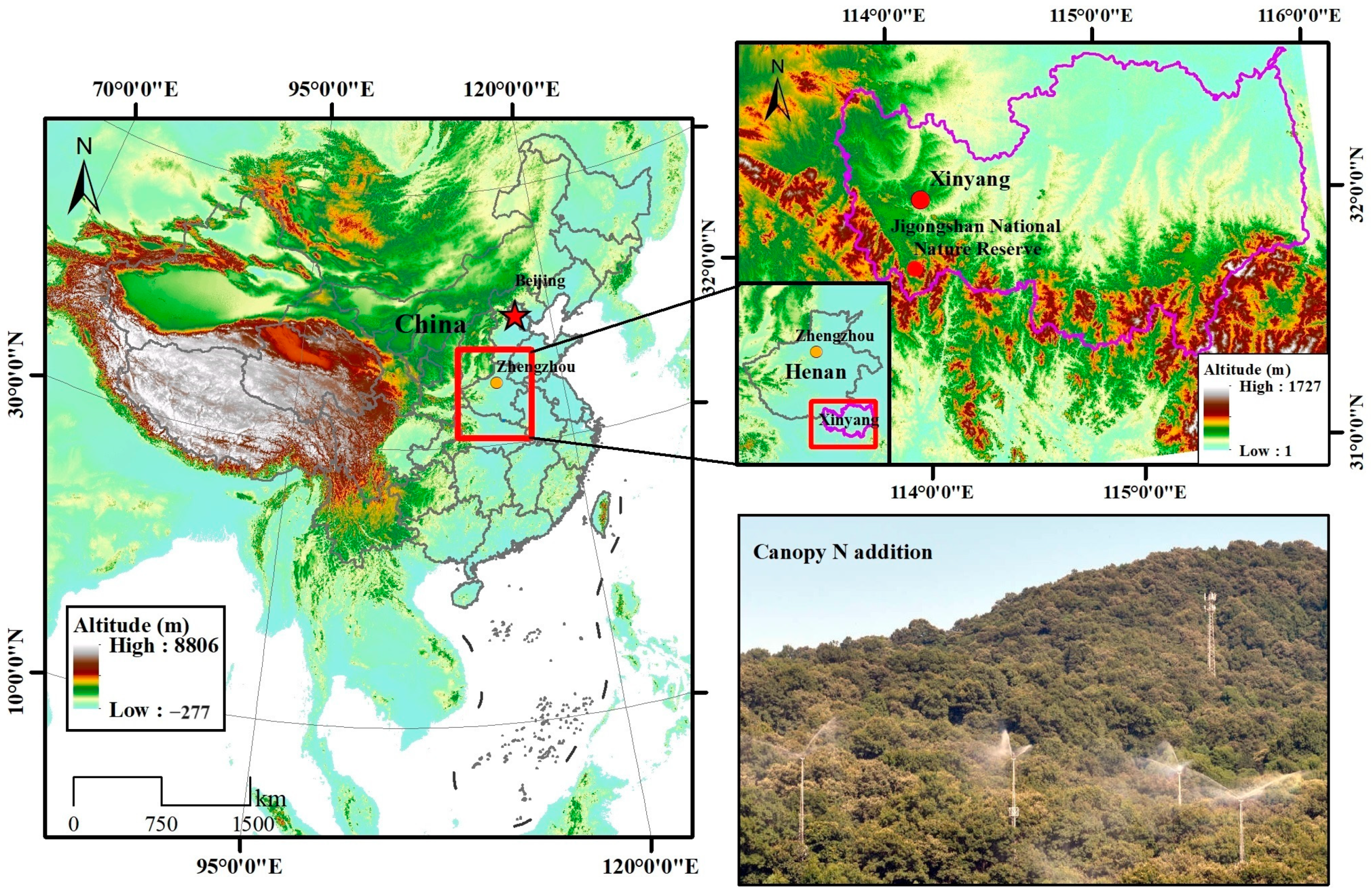
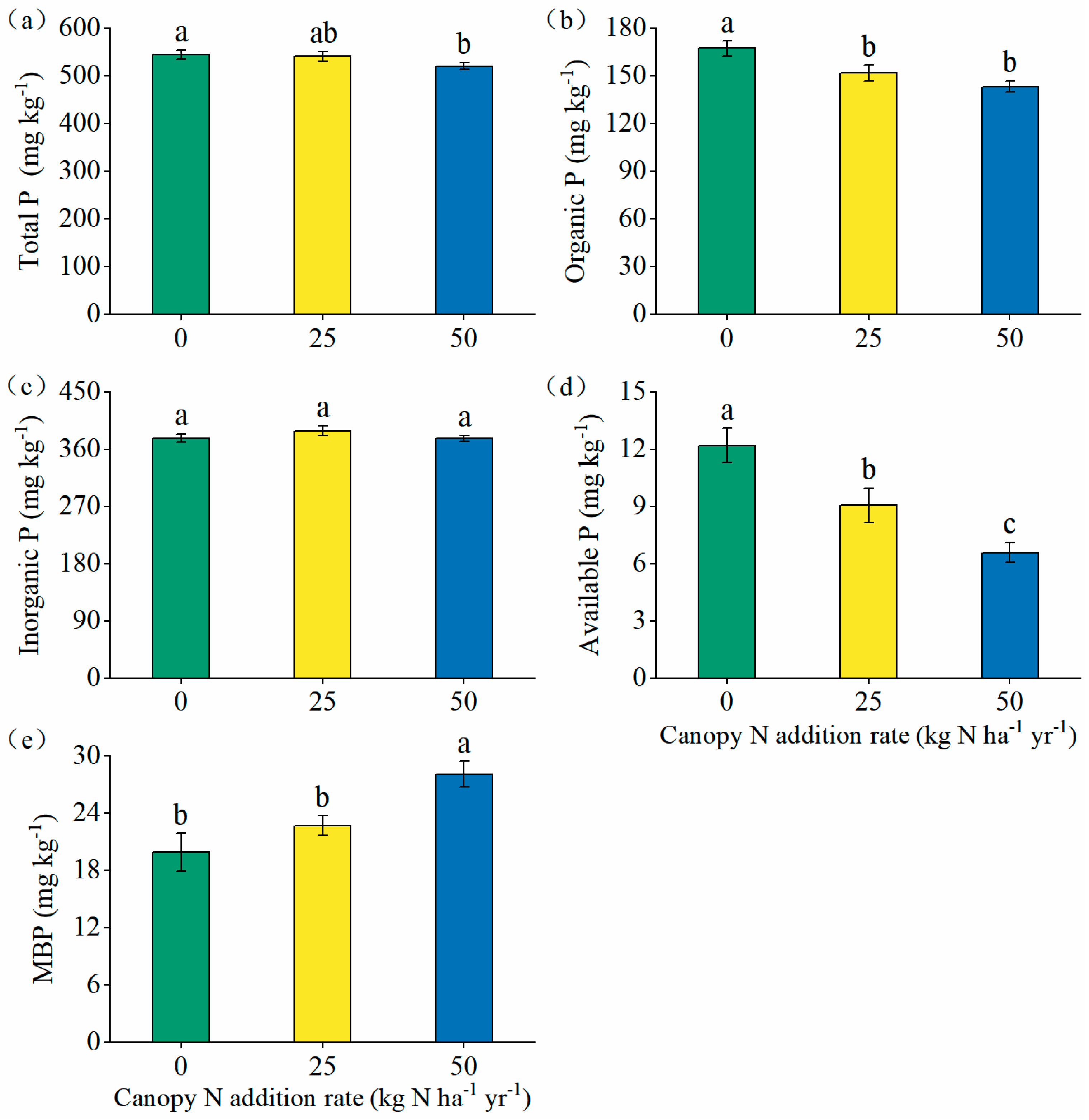

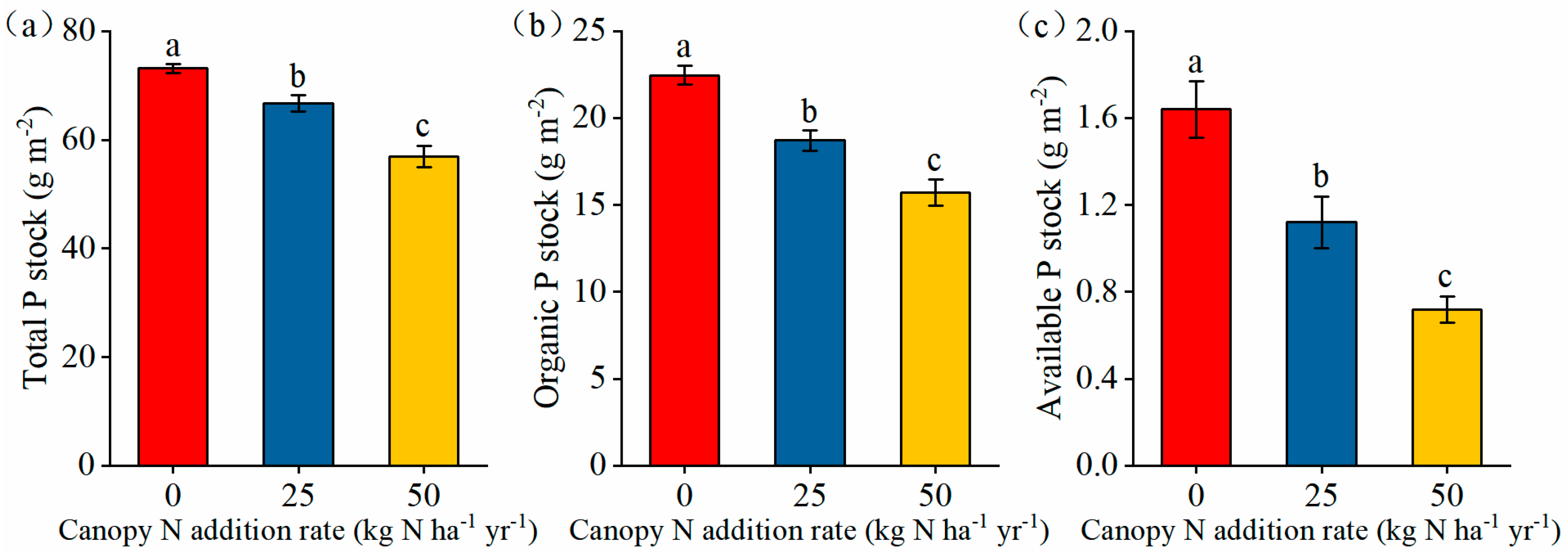

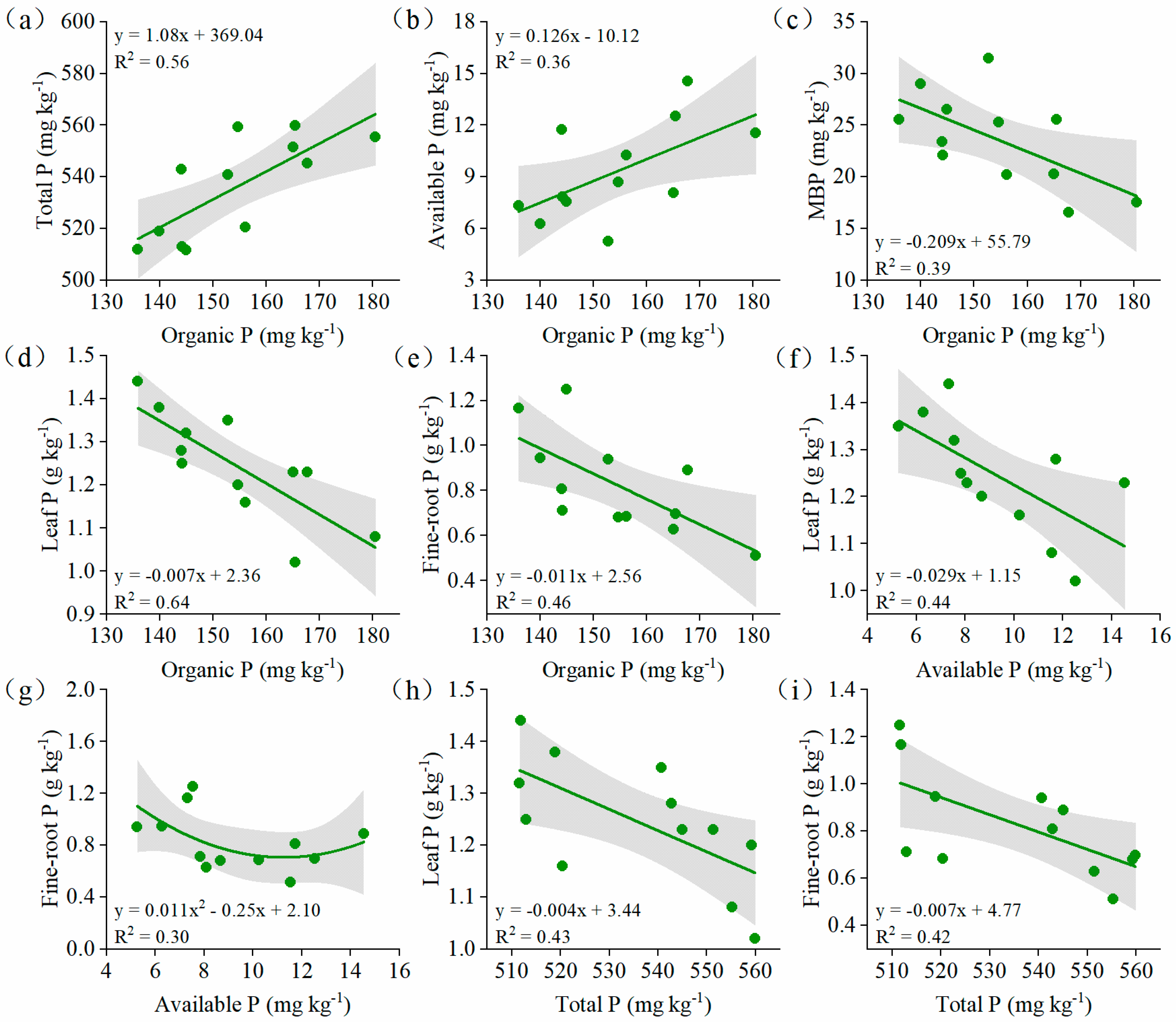
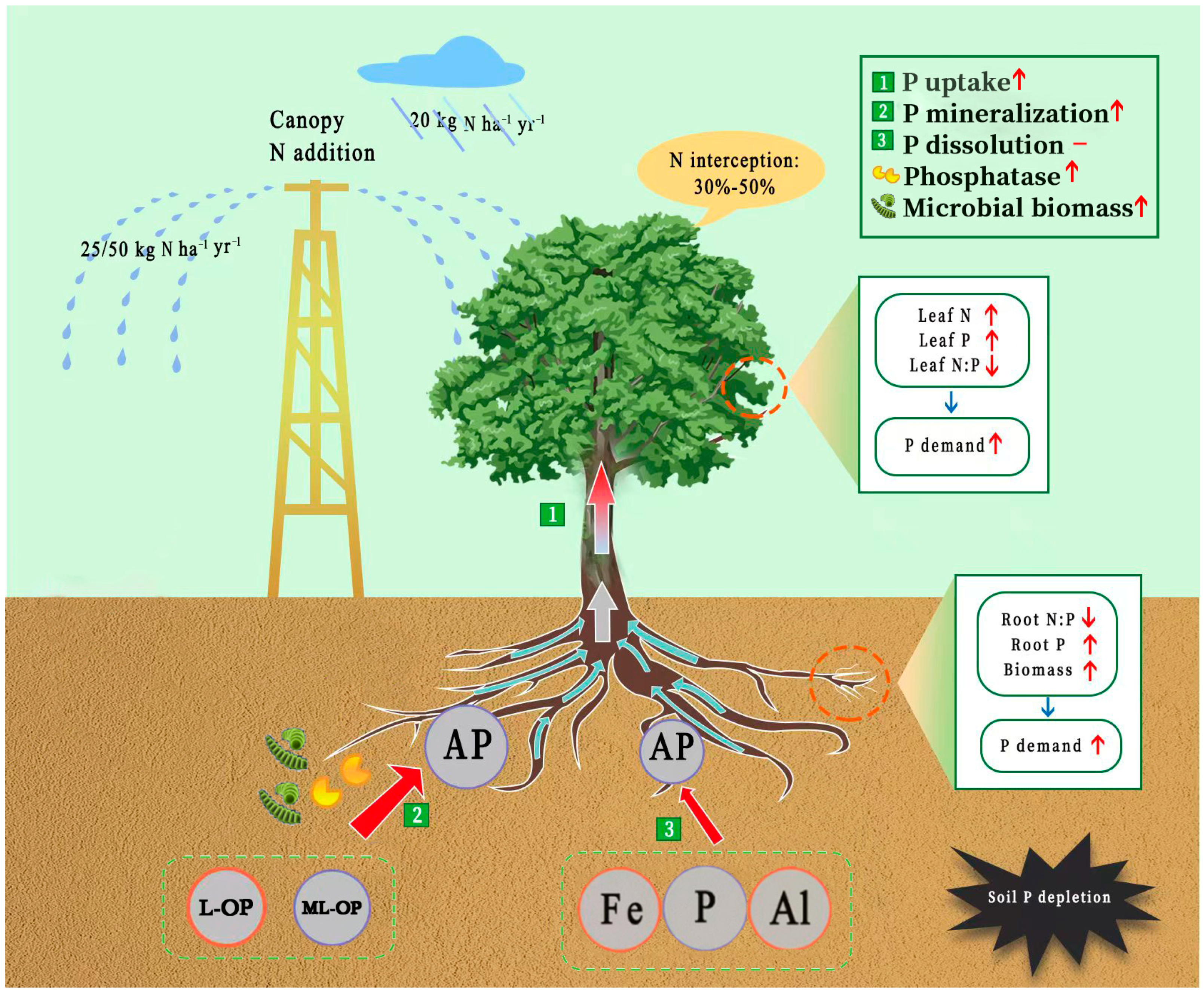
| Soil Properties | Canopy N Addition Rate (kg N ha−1 yr−1) | |||
|---|---|---|---|---|
| 0 | 25 | 50 | p | |
| pH | 4.23 ± 0.05 a | 4.14 ± 0.02 a | 4.05 ± 0.02 b | 0.009 |
| Soil moisture (%) | 17.75 ± 1.17 a | 18.13 ± 0.79 a | 19.19 ± 1.04 a | 0.599 |
| SOC (g kg−1) | 22.33 ± 1.14 c | 29.16 ± 0.95 b | 36.6 ± 2.35 a | 0.001 |
| Total N (g kg−1) | 2.18 ± 0.12 b | 2.34 ± 0.03 ab | 2.40 ± 0.06 a | 0.182 |
| Available N (mg kg−1) | 27.66 ± 0.82 b | 28.79 ± 0.51 b | 31.66 ± 0.49 a | 0.004 |
| Total P (g kg−1) | 545.16 ± 8.81 a | 541.65 ± 10.02 ab | 520.78 ± 6.86 b | 0.157 |
| Organic P (g kg−1) | 167.46 ± 5.03 a | 151.97 ± 5.02 b | 143.39 ± 3.64 b | 0.015 |
| Inorganic P (g kg−1) | 377.71 ± 6.24 a | 389.68 ± 7.91 a | 377.39 ± 4.39 a | 0.340 |
| Available P (g kg−1) | 12.21 ± 0.91 a | 9.08 ± 0.90 b | 6.63 ± 0.53 c | 0.003 |
| C/N | 10.30 ± 0.68 b | 12.48 ± 0.55 b | 15.31 ± 1.24 a | 0.010 |
| C/P | 40.98 ± 2.15 c | 53.9 ± 2.13 b | 70.48 ± 5.31 a | 0.001 |
| N/P | 4.01 ± 0.23 b | 4.32 ± 0.11 ab | 4.61 ± 0.06 a | 0.053 |
| Fe (×10−3 cmol(+) kg−1) | 2.46 ± 0.09 b | 3.06 ± 0.09 ab | 3.24 ± 0.11 a | 0.001 |
| Al (cmol(+) kg−1) | 2.39 ± 0.15 b | 3.14 ± 0.08 a | 3.50 ± 0.14 a | 0.001 |
| CEC (mmol(+) kg−1) | 77.35 ± 0.95 a | 73.29 ± 2.15 b | 70.69 ± 0.6 b | 0.025 |
| BS (%) | 61.65 ± 1.6 a | 60.94 ± 0.49 ab | 58.49 ± 0.7 b | 0.136 |
| Plant Organ | Canopy N Addition Rate | N (g kg−1) | P (g kg−1) | N/P |
|---|---|---|---|---|
| Leaf | 0 (kg N ha−1 yr−1) | 22.01 ± 0.69 b | 1.12 ± 0.05 c | 19.67 ± 0.83 a |
| 25 (kg N ha−1 yr−1) | 22.72 ± 0.86 ab | 1.24 ± 0.02 b | 18.33 ± 0.70 ab | |
| 50 (kg N ha−1 yr−1) | 24.73 ± 0.81 a | 1.37 ± 0.03 a | 18.03 ± 0.57 b |
| Plant Organ | Canopy N Addition Rate | N (g kg−1) | P (g kg−1) | N/P | Biomass (g m−2) |
|---|---|---|---|---|---|
| Fine-root | 0 (kg N ha−1 yr−1) | 12.88 ± 0.64 a | 0.70 ± 0.08 b | 19.33 ± 2.68 a | 184.80 ± 1.78 c |
| 25 (kg N ha−1 yr−1) | 11.53 ± 0.30 ab | 0.71 ± 0.04 b | 16.43 ± 0.78 a | 198.29 ± 1.50 b | |
| 25 (kg N ha−1 yr−1) | 10.21 ± 0.59 b | 1.08 ± 0.08 a | 9.54 ± 0.33 b | 226.82 ± 2.35 a |
Disclaimer/Publisher’s Note: The statements, opinions and data contained in all publications are solely those of the individual author(s) and contributor(s) and not of MDPI and/or the editor(s). MDPI and/or the editor(s) disclaim responsibility for any injury to people or property resulting from any ideas, methods, instructions or products referred to in the content. |
© 2024 by the authors. Licensee MDPI, Basel, Switzerland. This article is an open access article distributed under the terms and conditions of the Creative Commons Attribution (CC BY) license (https://creativecommons.org/licenses/by/4.0/).
Share and Cite
Gao, X.; Gao, Y.; Li, X.; Zhang, C.; Zeng, Q.; Yuan, X.; Chen, Y.; Yu, Y.; Fu, S. Eleven-Year Canopy Nitrogen Addition Enhances the Uptake of Phosphorus by Plants and Accelerates Its Depletion in Soil. Forests 2024, 15, 416. https://doi.org/10.3390/f15030416
Gao X, Gao Y, Li X, Zhang C, Zeng Q, Yuan X, Chen Y, Yu Y, Fu S. Eleven-Year Canopy Nitrogen Addition Enhances the Uptake of Phosphorus by Plants and Accelerates Its Depletion in Soil. Forests. 2024; 15(3):416. https://doi.org/10.3390/f15030416
Chicago/Turabian StyleGao, Xiaoli, Yinmei Gao, Xiaowei Li, Chenlu Zhang, Quanxin Zeng, Xiaochun Yuan, Yuehmin Chen, Yuanchun Yu, and Shenglei Fu. 2024. "Eleven-Year Canopy Nitrogen Addition Enhances the Uptake of Phosphorus by Plants and Accelerates Its Depletion in Soil" Forests 15, no. 3: 416. https://doi.org/10.3390/f15030416






